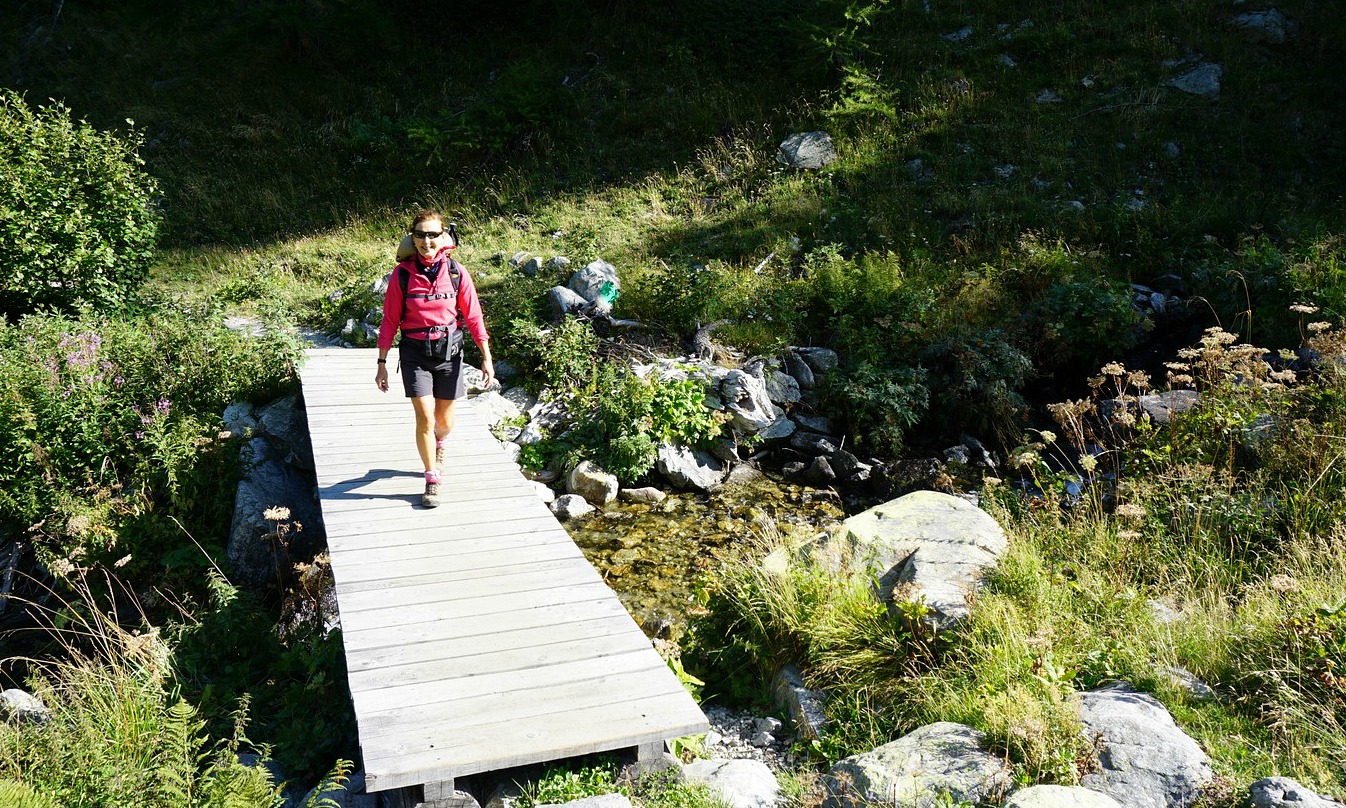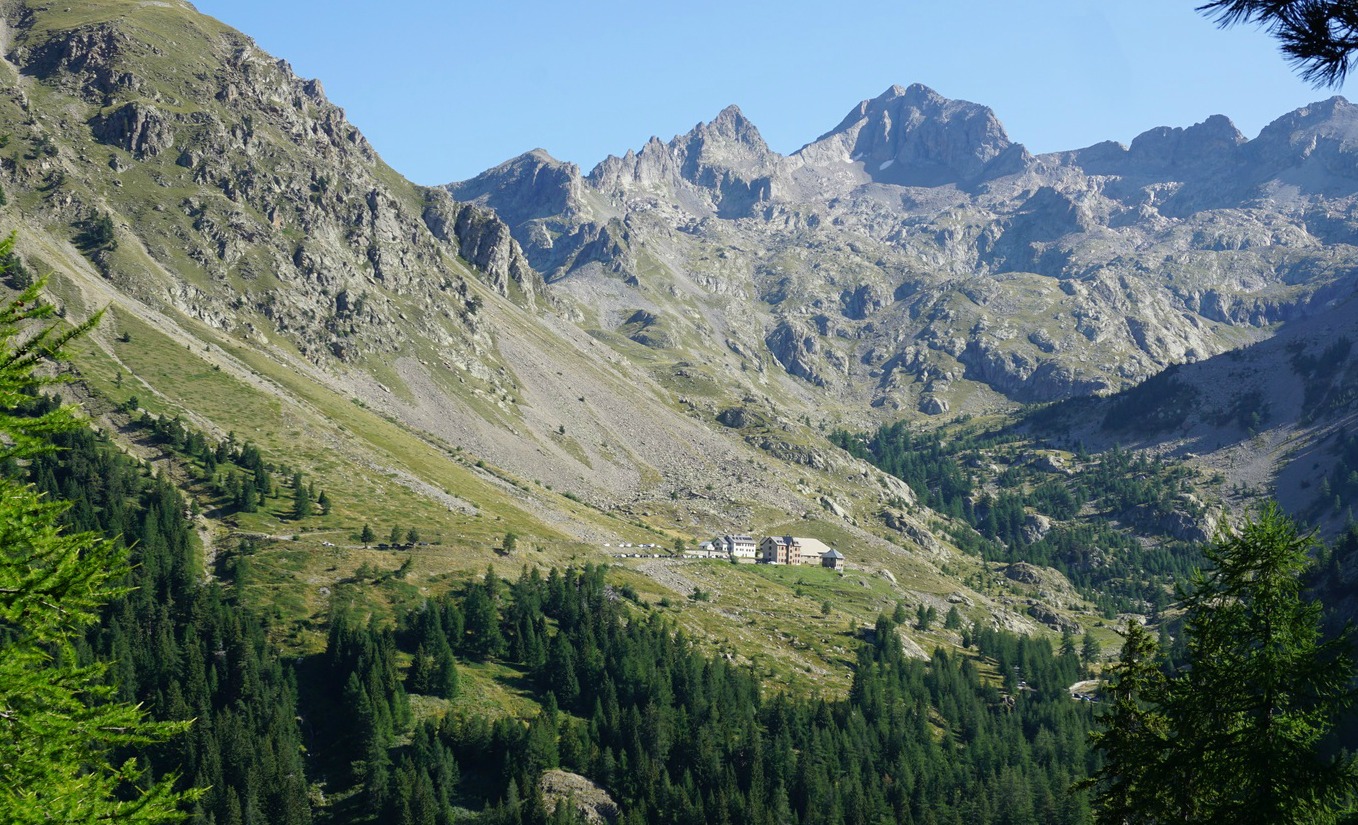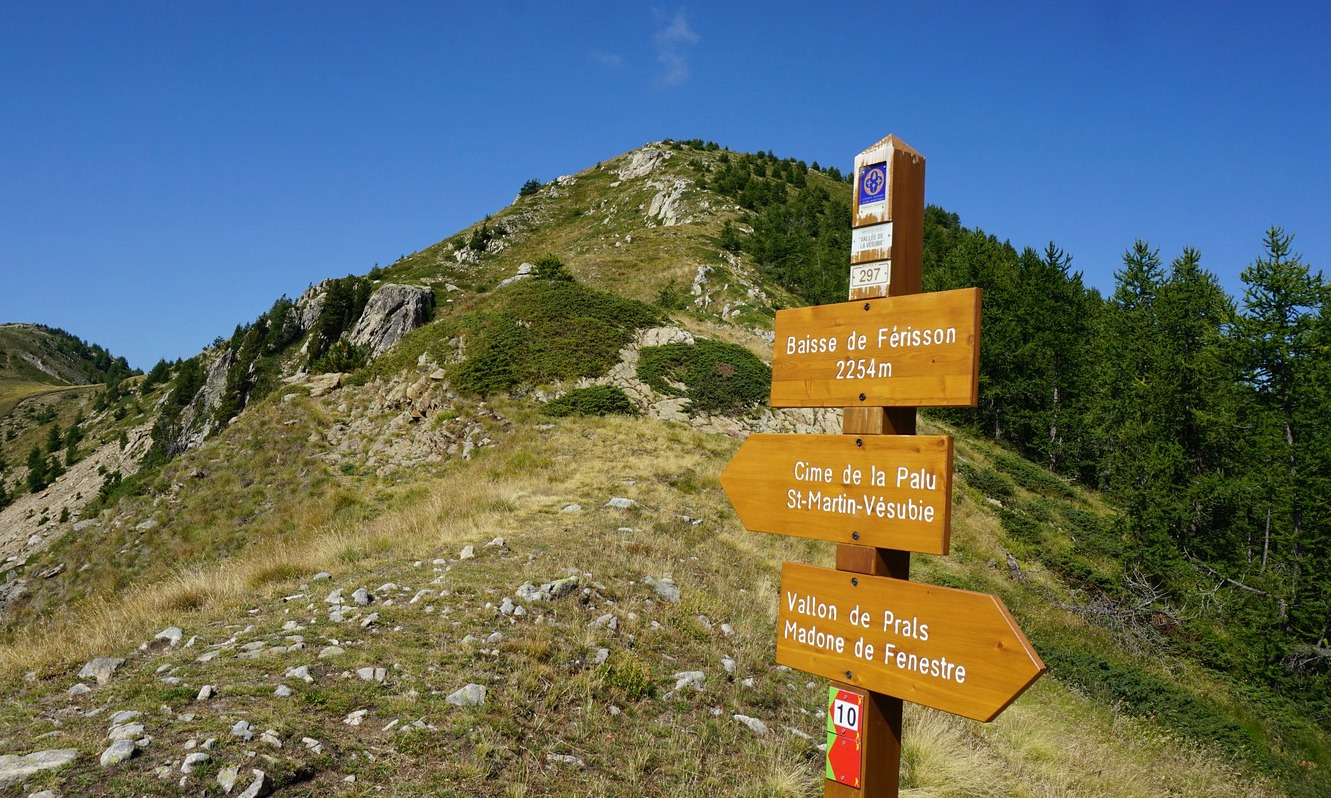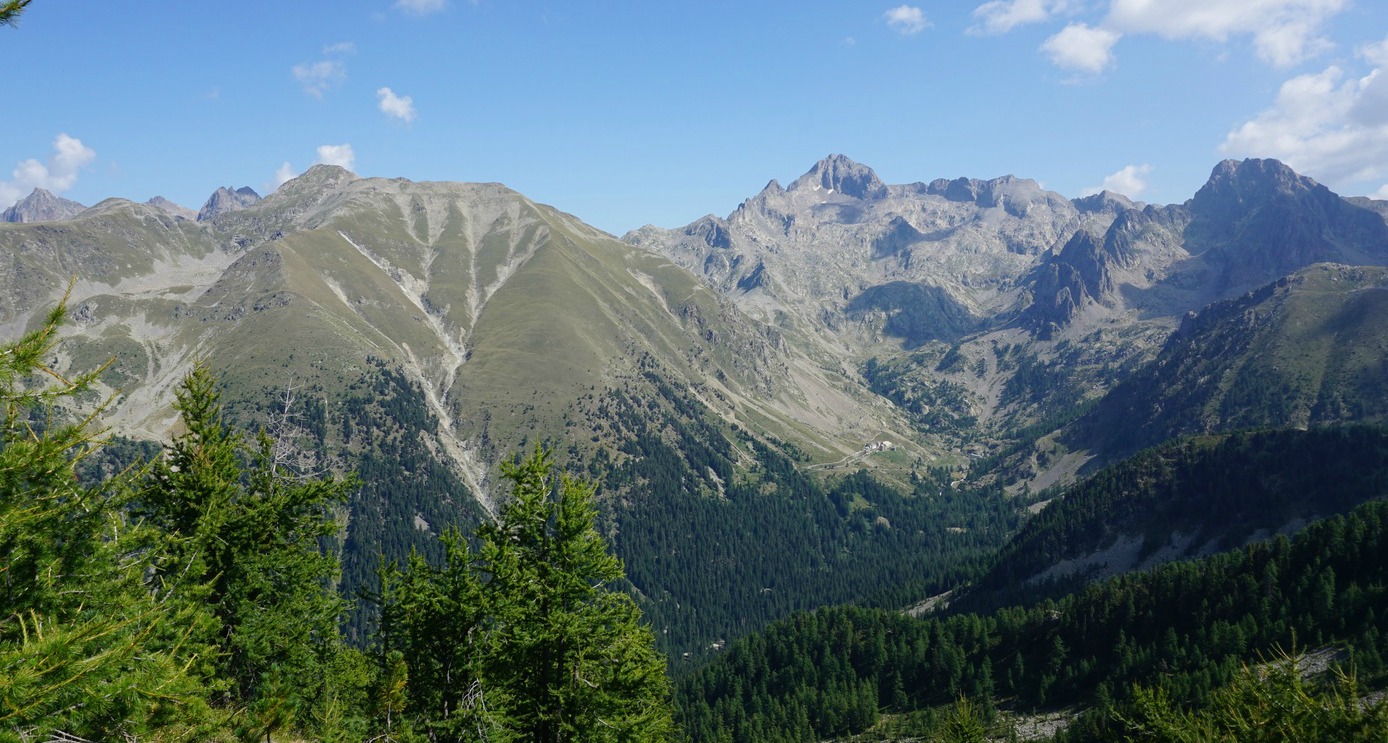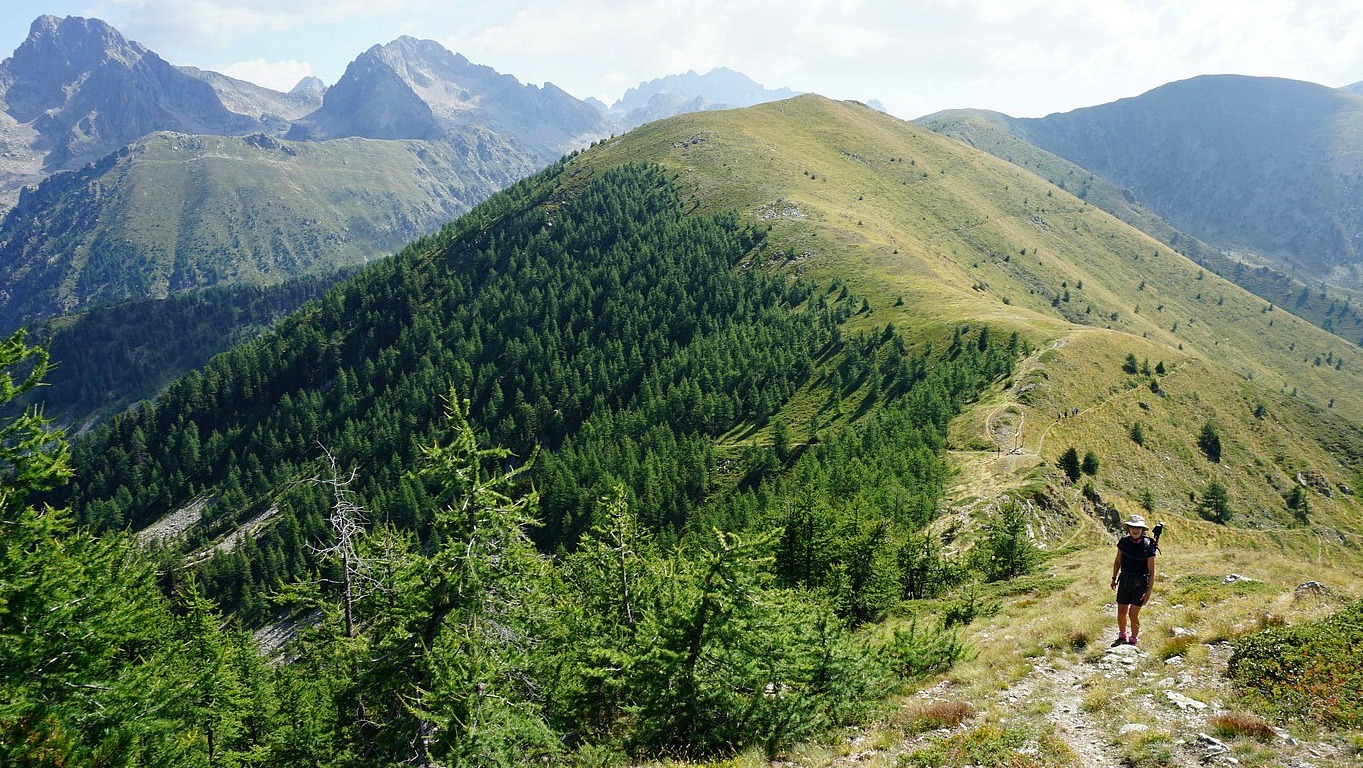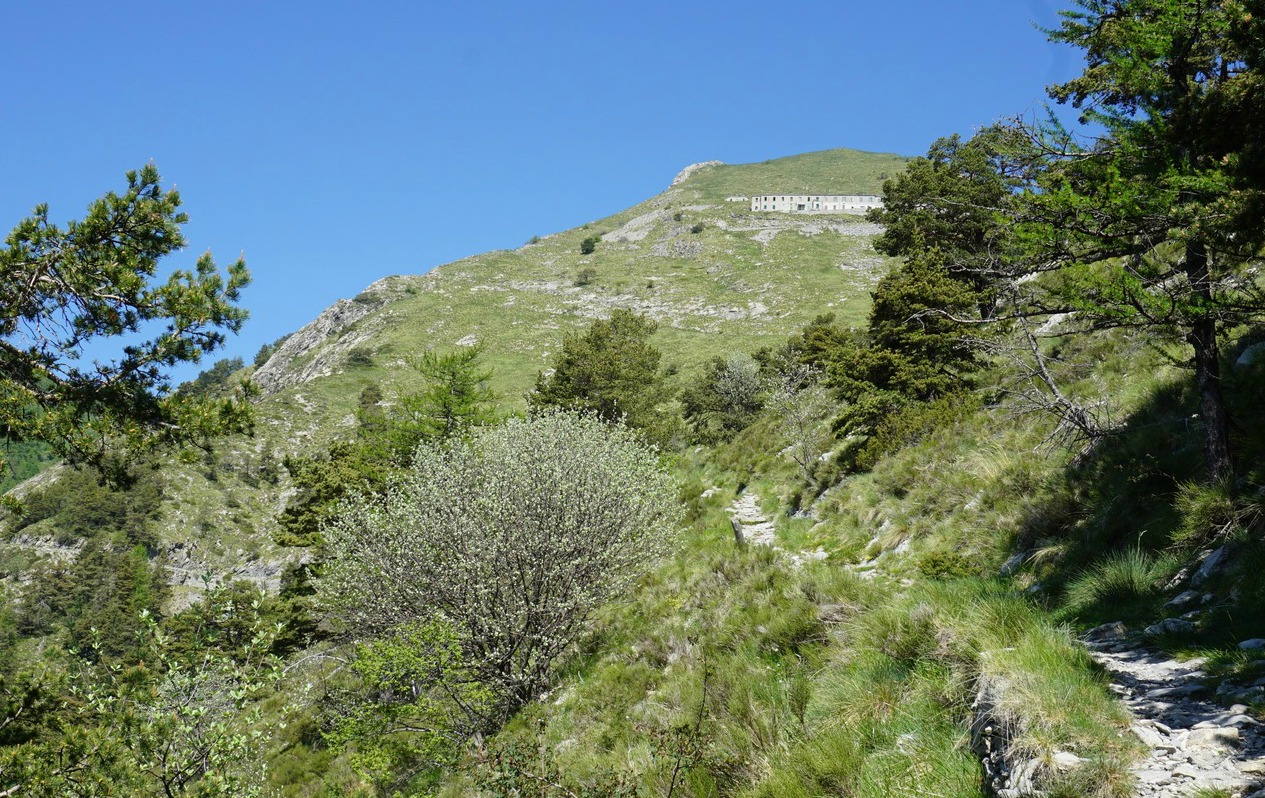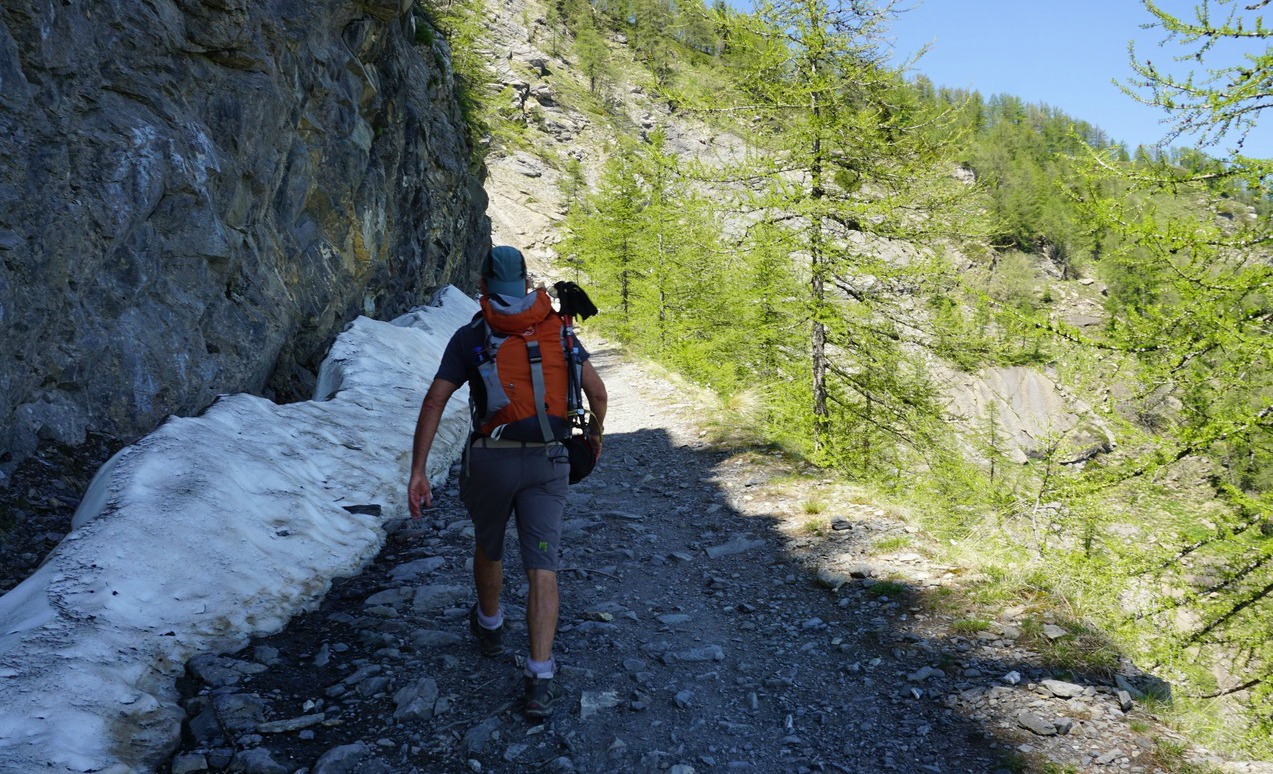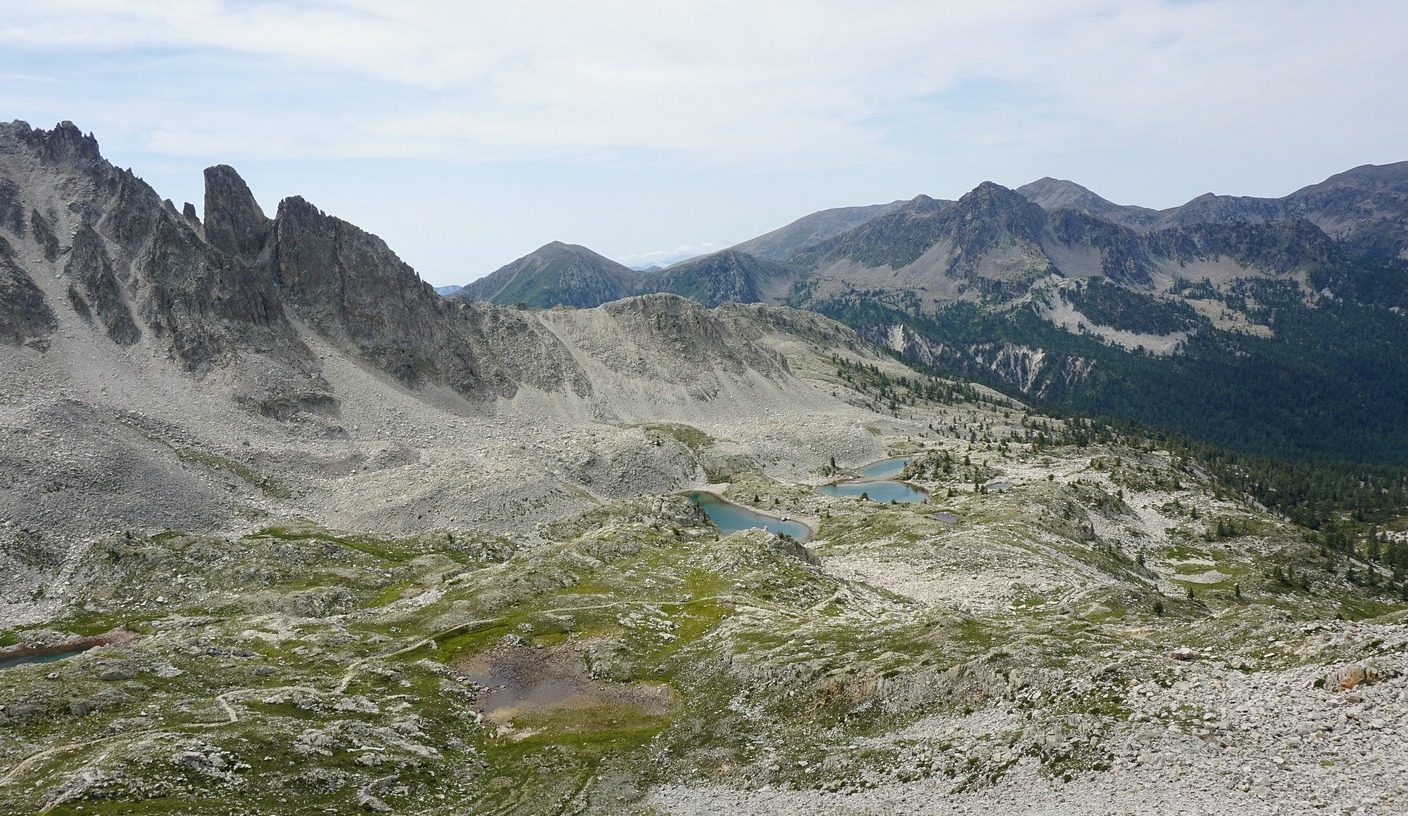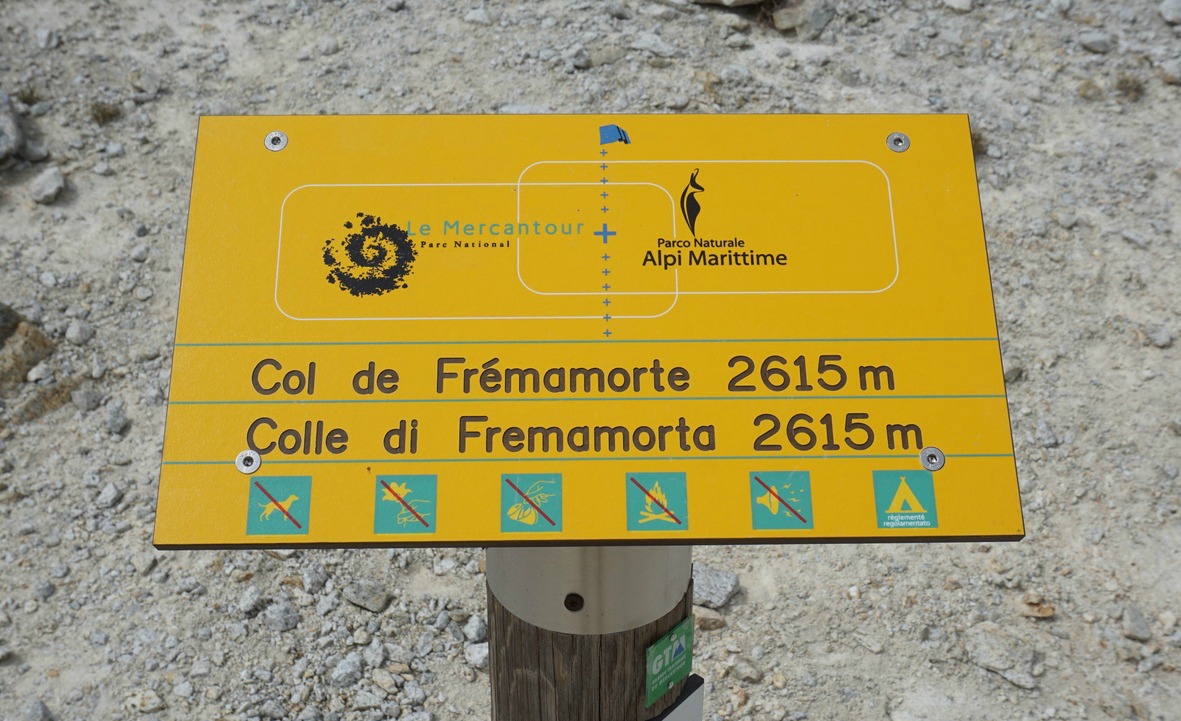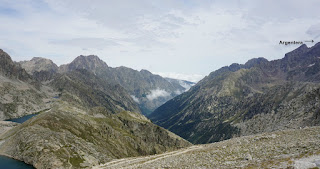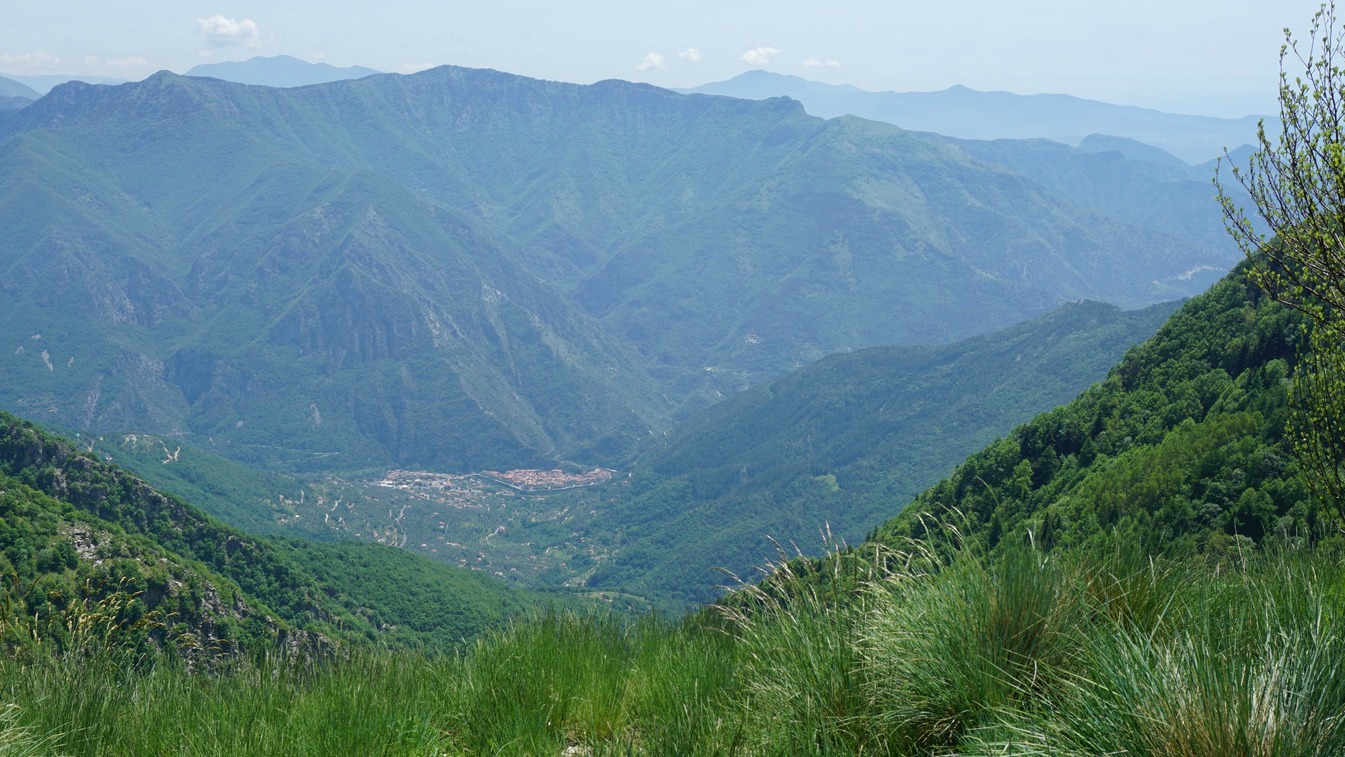

In the past, we have
made several good hikes from Madone de Fenestre (1820 m), such as Cime de la Valette de Prals. This time we wanted to make a shorter hike to the still
unexplored Mont Lapassé (2351 m). With a moderate effort, we were
rewarded by a super 360° panorama at the summit!
We started our hike from a small parking at 1790 m elev. by the M94 road, just below Madone de Fenestre. From here, we took a shortcut (140 m or so) directly to the main trail that went to Vallon de Prals. We crossed a stream along a wooden bridge and came to a crossroads at signpost #362. At this point we forked right, into the woods, heading to a mountain pass named Baisse de Férisson. The left-hand trail went up to the Prals Valley, to Lacs de Prals etc.
The ascent to Baisse de Férisson (2254 m) was a continuous 400 m climb from signpost #362. At the
pass, we had today’s goal about 100 m above us. The marked trail to Cime de la Palu circled along the southern flank of Mont Lapassé. We climbed to the summit along an unmarked trail. The summit was marked with a cairn and a stick, in
fact two cairns very near each other.
Mont Lapassé is in the middle of a chain of mid-altitude 2000 m+ summits between the Madone de Fenestre and Gordolasque Valleys. In this region, it is possible to tailor make your hike shorter or longer, and ascend to several summits during one day if
you wish.
We returned back to the valley along the same trail
Climb: 560 m
Distance: 8 km
Duration: 3h (Climb 1h 45) active
Map: 3741 OT Vallée de la Vésubie


This tasty vegetable gratin is great with a simple chicken breast or a steak.
2 servings
1 aubergine
2 tomatoes
1 clove garlic
1 tsp dried Provençal herbs
Freshly ground black pepper
200 ml tomato sauce
Two handfuls of freshly grated parmesan
About 4 tbsp. olive oil
Preheat the oven to 180° C.
Oil a small gratin dish with 1 tbsp. of olive oil. Wash and dry the aubergine and tomatoes. Then slice them.
Place ½ of the aubergine slices in the bottom of the gratin dish and cover with ½ of the tomato sauce. Add the tomato slices and sprinkle with 1 tsp. dried Provençal herbs. Peel the garlic clove and press over the tomatoes. Grind over some black pepper. Then cover with the rest of the aubergine slices and spread the rest of the tomato sauce on top of the aubergine slices.
Grate about two handfuls of parmesan and cover the gratin. Sprinkle 3 tbsp. olive oil on top of the parmesan and bake for 45 minutes.

Many years ago, we tried to reach the summit of Cime de Marta (2135 m) starting from the village of la Brigue in the Roya Valley. On that given day, however, the village was en fête; full of people, Medieval spectacles, and police directing traffic, so we never found the starting point of the trail to Cime de Marta.
This time, we started the ascent from the Italian side from Rifugio F. Allavena at Colla Melosa (1545 m) in the Ligurian Alps.
We first drove to Ventimiglia, then took the SP64 road north, passing Dolceaqua then Pigna. After Pigna, we forked right to SP65. This road got very narrow with continuous hairpin bends but at least it was paved! At a place named Colla di Longan, we forked left to Colla Melosa.
From Colla Melosa, we started along an old military track, then forked right to a path that went straight up to Rifugio Grai. It was a steepish ascent along a good trail. We came back to the military track, headed straight north along it, following the Franco-Italian border passing Col Bertrand (1979 m). We soon had Cime de Marta in sight, above the barrack ruins by the trail.
We continued along the dirt track a bit heading west, reached the ridge between Balcon de Marta and Cime de Marta where we forked right (east) and ascended to the summit hors sentier along the grassy western flank of the mountain. Wild orchids and violets decorated the alpine meadow but there were still large patches of snow on the northern slope. The summit was marked with a signpost (#254).
From the summit, we descended-again off-track-straight down to the barrack ruins and took the same route back to Colla Melosa.
The GPS track is shown below
Climb: 663 m
Distance: 11,3 km
Duration: 3h 30 (active)
Map: IGN 3841 OT Vallée de la Roya (the Italian side of the trail and Colla Melosa are visible on the French map)

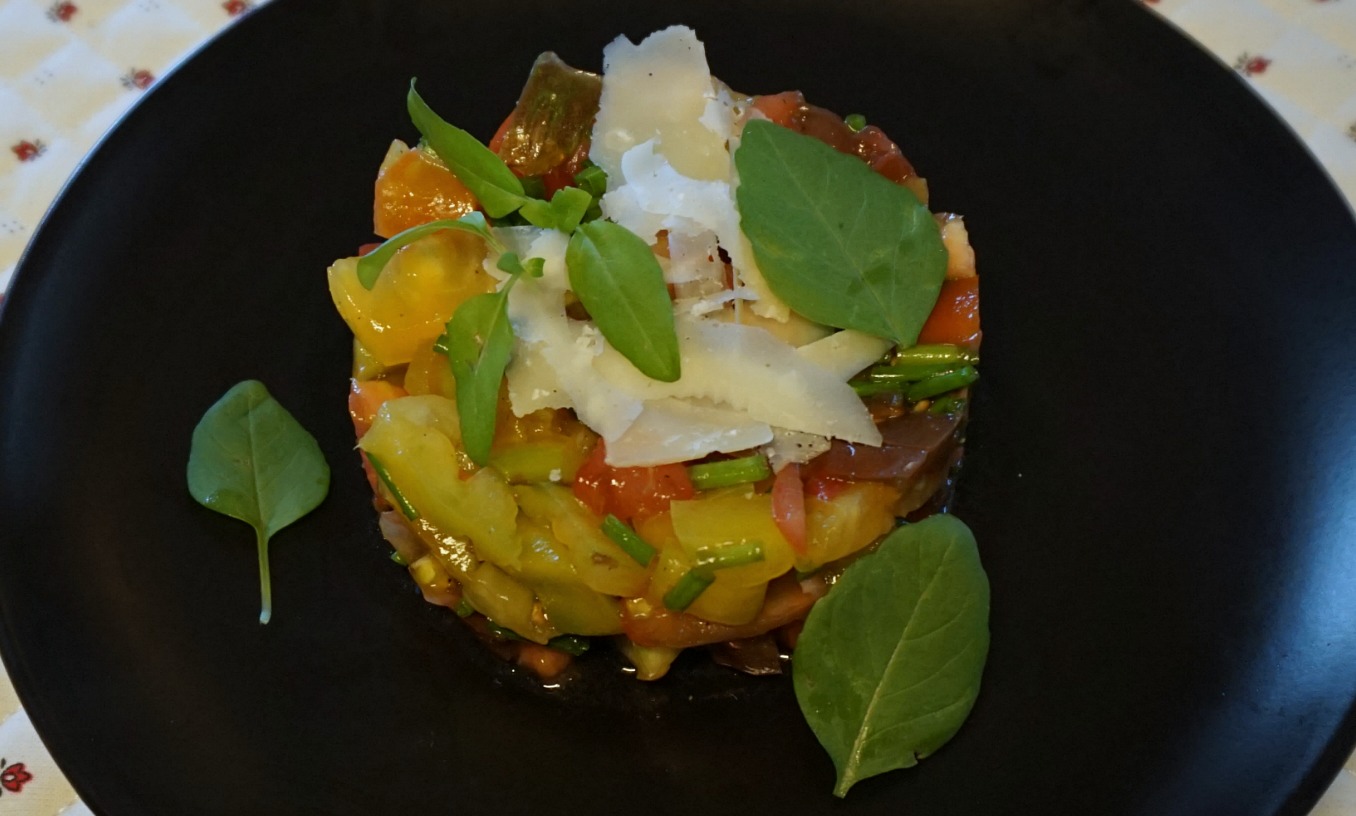
The following simple recipe makes an impressive starter in late summer or early autumn when tomatoes are in season.
2 servings
1 red tomato
1 yellow tomato
1 black tomato
1 tbsp. olive oil
1 tsp red wine vinegar
Chopped chives
Freshly ground black pepper
A few basil leaves
A few shavings of parmesan
Wash and dry the tomatoes. Cut them in small pieces and place for ten minutes in a sieve to release extra liquid. Then place them in a bowl. Add the olive oil, vinegar, black pepper and some chopped chives. Mix and let marinate for a few minutes.
Divide the tartare on the plates with the help of a stainless-steel preparation circle. Decorate with parmesan shavings and basil leaves.

In Alpes-Maritimes, there are several renowned mountain passes on the Franco-Italian border that can be reached by hiking trails, such as Baisse de Druos, Col de Fenestre, Col de Cerise and Pas du Préfouns. This time we wanted to ascend to a lesser known pass above Le Boréon named Col de Frémamorte (2615 m).
Unfortunately, on our given day the weather was more clouds than blue skies. Nevertheless, we had good views down to Italy from the col.
From the Salèse parking (1665 m) above Le Boréon we started ascending along the GR 52 trail towards Col de Salèse (2031 m) which we reached in 1 h 10. From Col de Salèse, we descended a bit then forked right, leaving the GR52, and headed towards Lac Négre, Pas du Préfouns and Col de Frémamorte. We ascended along the popular trail in the forest. Most hikers seemed to continue to Lac Négre. At a crossroads called Camp Soubran (2270 m) and signpost 270, we forked right (east).
Heading east above the tree line, we passed several lakes (Lacs de Frémamorte). The scenery became high-alpine, and the trail rockier.
Approaching the col, we saw remains of a bunker and even an odd ibex. The last push was actually less steep than anticipated as the trail zigzagged in the incline.
In front of us, on the Italian side, we could view the western flank of the imposing Argentera Massif (at 3297 m the highest peak in the Maritime Alps), several lakes below us, and in the distance the lowlands near Cuneo that were covered with low clouds. From the col, one trail descended down to Italy, the other, looking a bit exposed, went up to the nearby summit called Cime de Frémamorte (2730 m).
We descended along the same trail back to our starting point.
Climb: 960 m
Distance: 17 km
Duration: 5h 45 active
Map: IGN 3741 0T Vallée de la Vésubie

When the plums are in season, we eat some dark plums every morning and I also use them in cooking. The following recipe can be made from pitted prunes when the plum season is over.
2 servings
3 tbsp. olive oil
4 organic chicken thighs, with skin
4 large dark plums or pitted prunes
1 small onion, chopped
1 clove garlic, minced
100 ml white wine
2 tbsp. pitted green olives, pref. organic
1 tsp. dried Provençal herbs
Freshly ground black pepper
A glass jar of 250 g cooked white beans
Chopped chives
Preheat the oven to 200° C.
Spread 1 tbsp. olive oil in the bottom of an ovenproof dish. Place the chicken thighs in the dish skin side up.
Arrange the onion, garlic, and olives around the chicken and pour in the wine. Add the black pepper and herbs and sprinkle with 2 tbsp. olive oil. Bake for 30 minutes.
Meanwhile wash the plums, halve them and remove the stones. Rinse the white beans under running water. Add the beans and plums in the dish around the chicken and continue baking for 15 minutes.
Decorate with chopped chives.
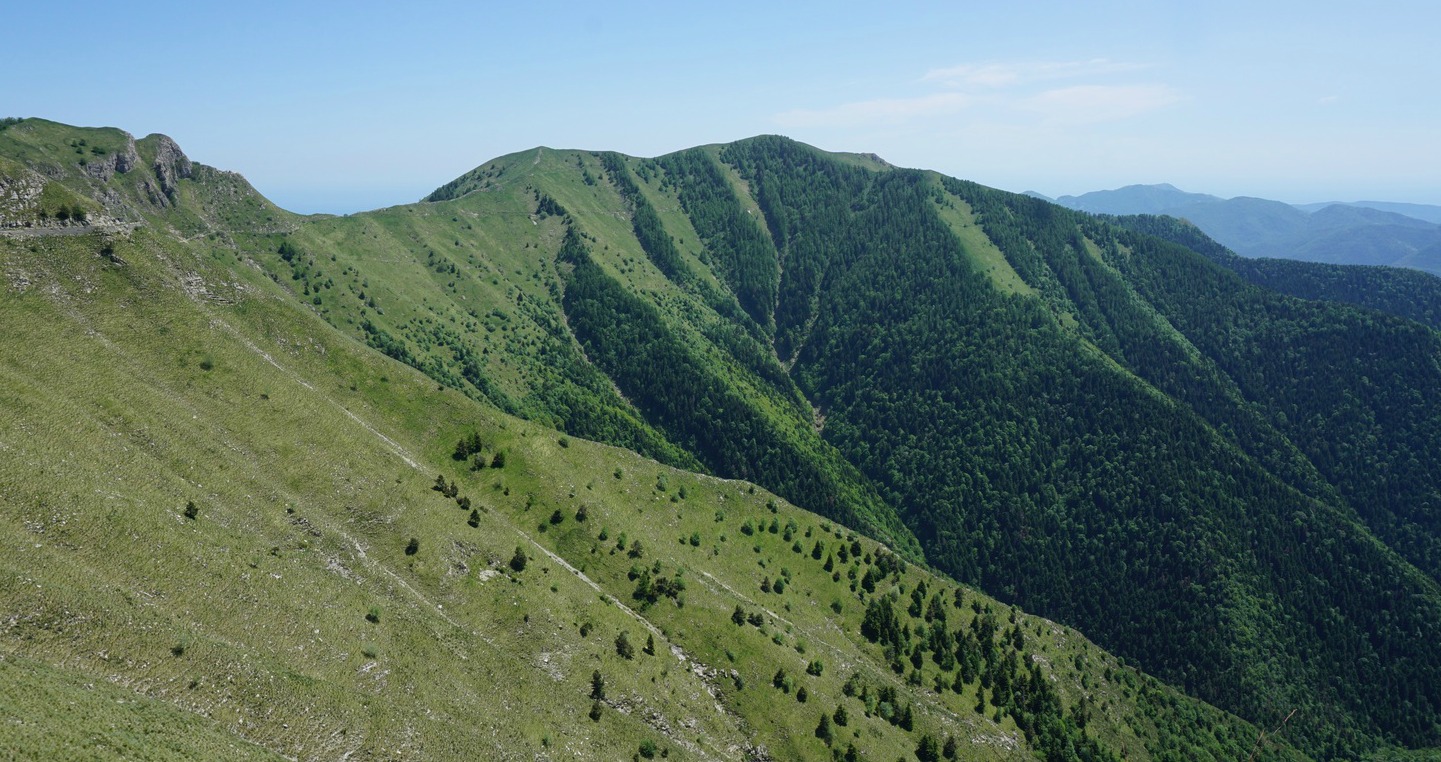
We have twice before tried to reach the summit of Mangiabo (1821 m) from Moulinet, but had to turn around because the weather turned bad.
Mangiabo which is situated inside the southern part of the Mercantour National Park, is only 18 km from the coast as the crow flies. It is also the southernmost major peak in the ridge that stretches south of Authion. Old military installations are omnipresent all along the route. It is possible to use the GR52 hiking trail that runs along the ridge, partly along dirt tracks, partly along good paths to reach Mangiabo. Compared with a route starting from Moulinet deep in the valley, the summit can be reached from Authion with much less vertical ascent.
On our third attempt the weather was favourable. We drove up to Col de Turini, then to Authion where we took the D68 road that circles counterclockwise the area. The road is paved but potholed, so proceed with care. We drove past Cabanes Vieilles and a cattle shelter and parked at the second sharp bend after the shelter.
We headed straight south along a wide dirt track (GR52) as far as to signpost #151 where we continued along a path in the woods marked with white and red i.e. GR colours. We followed the path to Baisse de Ventabren, took the GR52 trail that followed the eastern flank of Pointe de Ventabren to Baisse de la Déa. The ancient military track circles along the western flank, and we took it on the way back.
From Baisse de la Déa the trail ran along the western flank of the ridge, passing several bunkers. This part of the trail under Cime de la Gonella was a bit narrower and somewhat exposed. We passed signpost #142 and 143 and soon came to #144 from where we had an easy final ascent to the grassy summit marked with a cairn.
We had a super 360° panorama of the whole region. In spite of some haze, the Mediterranean, Cap d’Antibes etc were visible in distance, and of course the still snow-capped high peaks in the north.
We used the same itinerary back apart from the dirt track circling along the western flank of Pointe de Ventabren (see our GPS track below).
Total distance: 13 km
Total climb: 576 m
Duration: 3h 50 (active)
Map: IGN 3741 ET Vallées de la Bévéra et des Paillons

The following carefree recipe is full of flavours from the South of France. Red mullet is the Mediterranean choice of small fish fillets for this dish but other small fish fillets could also be used.
Tapenade, black olive paste, is an essential ingredient in the recipe. If you don’t have tapenade in your area, it is easy to make. In a food processor, combine a handful of best-quality pitted black olives, 1 tbsp. capers and 1 tbsp. olive oil. Process into a paste. Add more olive oil if the paste seems dry. The paste does not need to be wholly smooth.
2 servings
About 250 g red mullet fillets
A small jar of tapenade
1 fennel
2- 3 tbsp. olive oil
Two handfuls of baby spinach leaves
A handful of cherry tomatoes
1 garlic clove, minced
Fresh basil leaves
Wash and slice the fennel. Place in a microwave dish with a splash of water and microwave until soft.
Preheat the oven to 200° C.
From baking paper, cut two large pieces, about 40 x 40 cm. Divide the fennel in the centre of the papers and place half of the fish fillets on top. Add a generous teaspoon of tapenade on each red mullet fillet and top with the rest of the fillets. Fold the parcels tightly and bake for 10 minutes.
Meanwhile warm 1 tbsp. olive oil in a large casserole over medium heat and sauté the garlic for a few minutes. Add the spinach and sauté until wilted. This takes only a couple of minutes.
Wash the cherry tomatoes and cut into halves.
When the fish is done, remove the parcels from the oven and place directly n the plates. Open them and arrange the paper nicely. Divide the spinach on the side and scatter the cherry tomato halves on top. Sprinkle with some olive oil and decorate with basil leaves. Serve the parcels with some good country bread.




